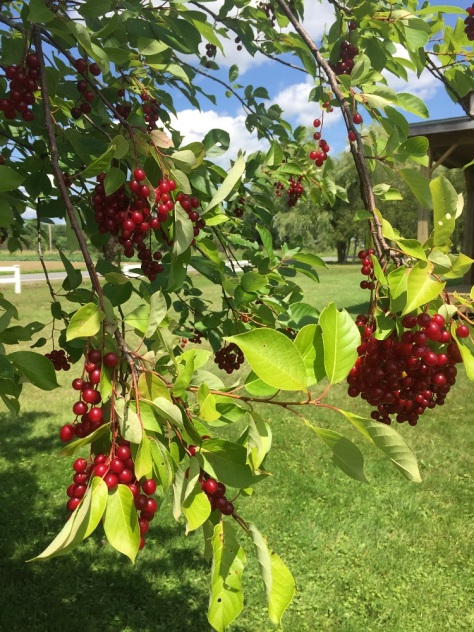
So it’s been a banner year for chokecherries.

Seriously, the tree is full.

Since I’ve always wondered why the birds never ate them, I did a little research.

And discovered that even though you can make jam with them….
Eaten raw?
They’re full of cyanide!
Who knew?

Maybe that explains my anti-social tendencies. I ate ’em by the handful and loved the astringent puckering and throat numbing.
LikeLike
A little puckering never hurts…
LikeLike
Does Fred know? Was it really a heart attack he had? I heard you were nicknamed the ‘possible black widow of Maine’! LOL
LikeLike
I may have inadvertently dropped a few in his salad….
*kidding*
LikeLike
Will be watching Fred carefully now………………
LikeLike
No worries, he’s safe. But it’s rather nice to know you have a poison supply readily available should the need arise. (o;
LikeLiked by 2 people
Send me some ‘jam’?
LikeLike
how would one get the cyanide out to make a jam, or does the cooking process take care of that…
LikeLike
According to the experts….
“Most parts of chokecherry are toxic to humans and livestock. Digestion of chokecherry seeds, leaves, twigs and bark by enzymes in the stomach releases cyanide (also called hydrocyanic or prussic acid). Cyanide poisoning can occur with fresh, bruised, wilted or dried foliage. It is possible for a person or animal to die of cyanide poisoning if not treated within minutes of ingestion. Cases of poisoning in livestock have been reported. However, it is not usual for such poisonings to occur at times when other, more palatable forage is available. Cases of poisoning have been reported for children who chewed on twigs, or ate the cherries without discarding the pits. The fleshy portion of the chokecherry fruit is not poisonous and can be safely eaten, although it is extremely tart. It is frequently combined with other types of fruit to make pies and jellies.”
LikeLike
so why did birds know this and humans don’t…LOL
LikeLike
Lots of dead bird relatives…?
LikeLike
guess you’d have to possess a bird brain to know…LOL…have a gr8 day!
LikeLike
Taking notes and making jam! ‘im indoors better watch his step heh heh heh
LikeLiked by 1 person